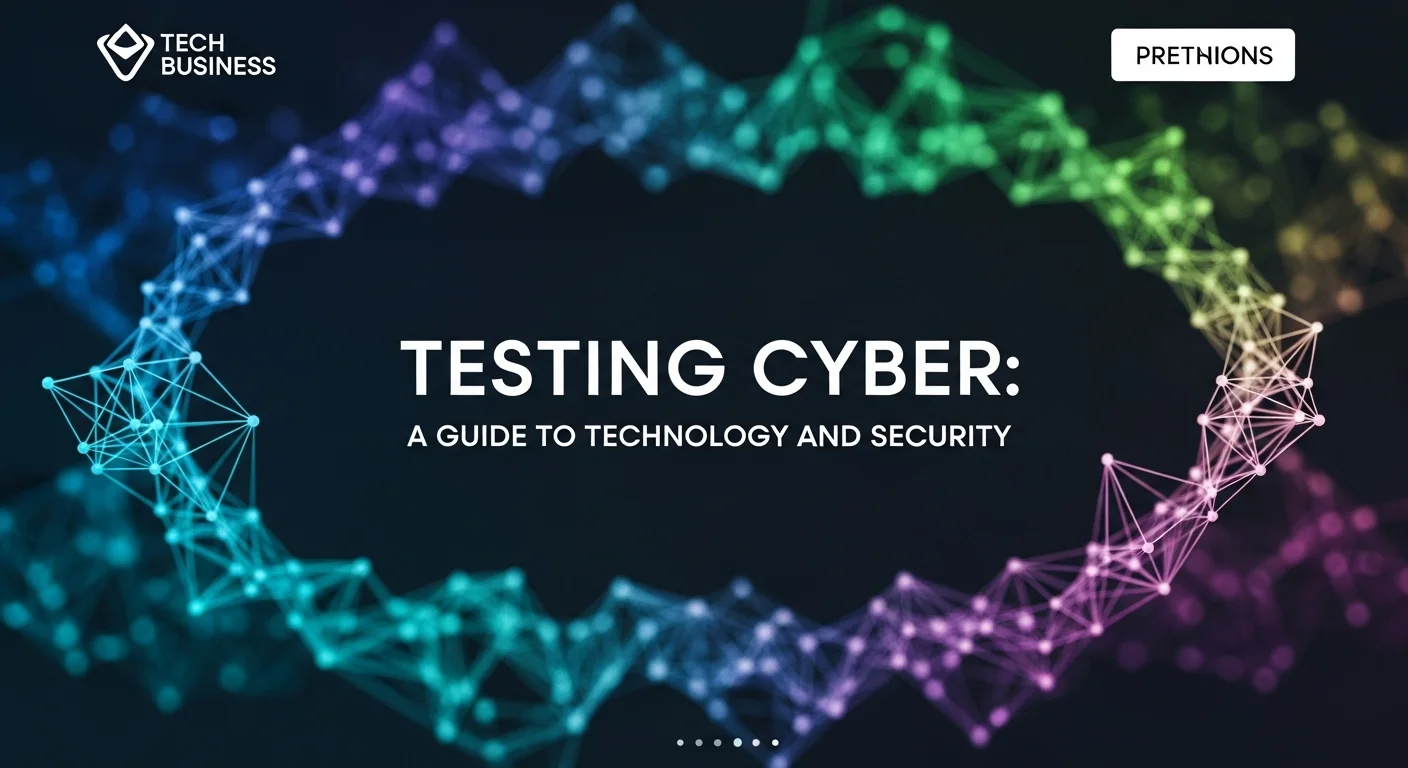Cyber Security Testing Explained: A Practical Guide to Protecting Your Business

Executive Summary
In all my years working in digital security, I've seen one thing over and over: the businesses that thrive are the ones that don't wait for a disaster to happen. They're proactive. That's what cyber security testing is all about. Think of it as a comprehensive health check-up for your company's digital life. It's the process of intentionally looking for weaknesses in your systems—your website, your network, your apps—before someone with malicious intent finds them for you. This guide is my attempt to cut through the jargon and give you a real-world look at how security testing works. Whether you're a business owner wanting to protect customer data or a tech enthusiast curious about the field, understanding these principles is no longer optional. It's essential for building trust, staying compliant, and keeping your digital doors locked tight against an ever-changing landscape of threats.
Table of Contents
Table of Contents
What is Cyber Security Testing and Why Does It Matter?
In our hyper-connected world, your business's digital presence is like its physical storefront. Cyber security testing is the practice of checking the locks on your doors and windows to make sure they're secure. At its core, it’s about proactively searching for security weaknesses in your computer systems, networks, and applications. The goal is simple: find and fix these gaps before an attacker can use them to cause damage. I've seen firsthand how devastating a breach can be, not just financially but to a company's reputation. Every new technology we adopt—cloud services, remote work, smart devices—creates new potential entry points for criminals. Regular, thorough security testing is what allows you to stay a step ahead of these threats and ensure your critical systems remain safe and reliable.
The headlines are filled with horror stories that serve as stark reminders of the stakes. Remember the massive data breaches at big companies that compromised millions of user accounts? Many of those incidents could have been prevented or significantly reduced with rigorous penetration testing. These events prove that no organization is too big or too small to be a target. From my experience, dealing with the fallout of a breach is always more expensive and chaotic than investing in proactive defense. By simulating a real-world attack, you gain priceless insights into your true security posture and can make smart decisions to strengthen your defenses.
The Core Concepts: Scanning vs. Pen Testing
To really get a handle on security testing, it helps to know the difference between the main approaches. People often use these terms interchangeably, but they are quite different.
- Vulnerability Scanning: Think of this as a quick, automated security check-up. A specialized tool scans your systems against a huge database of known vulnerabilities, like outdated software or weak default passwords. It's a passive process; it points out the potential weak spots without trying to break in. I recommend running these scans frequently, maybe weekly or monthly, to maintain good security hygiene.
- Penetration Testing (Pen Testing): This is where things get serious. A pen test is a simulated cyberattack performed by a certified professional, often called an ethical hacker. Unlike an automated scan, a human is involved, bringing creativity and problem-solving to the table. We don't just find vulnerabilities; we actively try to exploit them to see how much access we can gain. The goal is to determine the real-world risk and potential business impact. It's the ultimate test of your defenses.
- Security Audits: This is a more formal review, checking your systems against a specific checklist, often for regulatory compliance. An audit ensures you're meeting standards like GDPR, HIPAA, or PCI DSS.
- Risk Assessment: This goes a step further. It's not just about finding flaws, but about prioritizing them. A risk assessment helps you understand which threats are most critical so you can focus your resources where they'll have the biggest impact.
When you combine these methods, you create a powerful, layered defense. Regular scans catch the common issues, while deep-dive pen tests prepare you for a determined attacker.
The Real-World Benefits for Your Business
Investing in a solid security testing program brings tangible benefits that protect your entire organization.
1. Prevent Disasters: The most obvious benefit is finding and fixing holes before they're exploited. This proactive approach dramatically reduces the risk of a data breach, saving you from financial loss, downtime, and legal trouble.
2. Meet Compliance Demands: Many industries have strict rules about protecting data. Regular security testing is often a requirement to comply with standards like PCI DSS (for credit cards) or HIPAA (for healthcare). Staying compliant helps you avoid massive fines.
3. Protect Your Reputation: A data breach can destroy the trust you've built with your customers. Showing a commitment to security through regular testing demonstrates that you value and protect their data, which is a huge competitive advantage.
4. Smart Financial Investment: The cost of cleaning up after a breach—fines, legal fees, recovery—is astronomical compared to the cost of proactive testing. Finding weaknesses early is one of the most cost-effective decisions a business can make.
5. Build a Stronger Defense: The reports from a pen test provide a clear, prioritized roadmap for improving your security. They help your team focus on what matters most, building a more resilient and adaptive defense system over time.

A Deep Dive into Testing Methods and Strategies
A truly effective cyber testing program goes beyond just running a scan. It requires understanding different methodologies to simulate various threats and a solid strategy to tie it all together. Here’s a look at the technical methods and business strategies I use to build robust digital defenses for my clients.
The 'Box' Approaches: Simulating Different Attackers
One way we categorize penetration tests is by how much information the ethical hacker has at the start. I like to explain it with a simple analogy of breaking into a building.
- Black Box Testing: This is the ultimate real-world simulation. I'm given nothing more than your company's name or a web address. It's like standing outside a building with no inside knowledge, just like a real external hacker. I have to do all the reconnaissance from scratch to find a way in. This is great for testing your perimeter security, but it can be time-consuming and might miss vulnerabilities that are only visible from the inside.
- White Box Testing: This is the complete opposite. You give me everything: source code, network diagrams, admin passwords. It’s like being handed the building's blueprints, security codes, and every key. The goal is a deep, exhaustive analysis to find flaws in code, architecture, and internal systems. This is perfect for simulating an insider threat, like a rogue employee, or an attacker who has already breached the perimeter. It’s the most thorough test you can do.
- Grey Box Testing: This is the happy medium and often the most efficient approach. I'm given some limited information, like the login credentials for a standard user. It's like being a guest in the building and seeing what sensitive areas I can access. This simulates an attacker who has already gained a small foothold, perhaps through a phishing email. It lets us focus on what happens *after* a breach, answering the question: 'How much damage can a compromised user account really do?'
Key Frameworks and Standards I Rely On
To ensure my testing is structured and comprehensive, I don't just improvise. I lean on established industry frameworks that represent the collective wisdom of thousands of security experts.
- OWASP (Open Worldwide Application Security Project): If you have a web application, OWASP is your best friend. Their 'Top 10' list is the industry-standard checklist for the most critical web security risks. I use it as a starting point for almost every web application test.
- NIST Cybersecurity Framework (CSF): This framework from the U.S. National Institute of Standards and Technology helps organizations structure their entire cybersecurity program. Testing fits perfectly into its 'Detect' function, and it ensures that our technical work aligns with your broader business goals.
- PTES (Penetration Testing Execution Standard): This standard provides a clear, seven-phase methodology for conducting a pen test, from initial planning to final reporting. It ensures nothing gets missed along the way.
My Essential Toolkit
While my experience is my most important tool, I rely on a powerful arsenal to work efficiently. Here are a few staples you’d find in my digital toolkit:
- Network and Port Scanners (like Nmap): This is my mapmaker. It helps me discover what systems are on a network and what services are running, giving me a layout of the potential attack surface.
- Vulnerability Scanners (like Nessus): These automated tools are great for a first pass, quickly identifying common vulnerabilities and 'low-hanging fruit.'
- Web Proxies (like Burp Suite): For web application testing, this is my magnifying glass. It sits between my browser and the server, letting me intercept and manipulate traffic to find complex flaws like SQL injection.
- Exploitation Frameworks (like Metasploit): This is how I safely test if a vulnerability is truly exploitable. It’s a controlled environment for launching simulated attacks to confirm the risk.
Building a Smart Cyber Testing Strategy
An effective testing program is a continuous cycle, not a one-time event. Here's a simple, strategic plan to get you started:
1. Know What You're Protecting: First, make a list of your most important assets—the data, systems, and software that are critical to your business. Prioritize them so you can focus your testing efforts where they matter most.
2. Set Clear Goals: For every test, define what you want to achieve. Are you testing a new app before launch? Meeting a compliance deadline? Be specific about the scope to ensure the results are meaningful.
3. Decide How Often to Test: High-risk, public-facing systems should be tested frequently—quarterly, or after any major update. Lower-risk internal systems might only need an annual test. Automated scanning should be running continuously in the background.
4. Use a Mix of Tests: A mature strategy uses a blend of approaches. Use automated scanning for broad coverage, regular grey box tests for critical apps, and an annual black box test to check your external defenses.
5. Fix, Retest, and Repeat: The test isn't over when you get the report. The most important step is creating a process to fix the vulnerabilities, then retesting to make sure the fixes worked. This cycle is what truly strengthens your security over time.

Best Practices and Common Mistakes to Avoid
Over the years, I've learned that a successful security testing program is about more than just technology. It’s about mindset, process, and communication. Here are some of my top tips and strategies—along with common pitfalls I see all the time—to help you get the most out of your security investment.
My Best Practices for an Effective Testing Program
Follow these guidelines, and you'll turn your testing from a simple compliance task into a real driver of security improvement.
Establish Clear Rules of Engagement: This is the single most important step. Before I touch a single system, everyone must agree on the scope (what's being tested) and the rules (what's allowed, when to test, who to call in an emergency). A clear plan prevents misunderstandings and accidental disruptions.
Combine Automation with Human Expertise: Relying solely on automated scanners is a huge mistake. They’re great for catching known issues, but they can't find complex flaws or understand business logic. The best strategy, in my experience, is to use automation for wide coverage and pair it with in-depth, manual penetration testing by a skilled professional. This gives you the best of both worlds.
Test from Different Angles: Don't just focus on hackers from the outside. What about a disgruntled employee or a user whose account gets stolen? A grey box pen test is perfect for simulating these insider threats. Also, remember to assess the security of your key suppliers and partners; a vulnerability in their systems can easily become your problem.
Have a Plan to Fix What You Find: A long report of vulnerabilities is useless without a plan. You need a structured process to prioritize the findings based on risk. Work with your team to assign fixes, set deadlines, and track progress. The failure to remediate is the failure of the entire exercise.
'Shift Left' – Test Early and Often: In development, 'shifting left' means building security in from the start, not tacking it on at the end. It's far cheaper and easier to fix a security flaw in the design phase than in a live application. Train your developers in secure coding and include security experts in planning reviews.
Common Mistakes to Avoid in Penetration Testing
I see many organizations fall into the same traps. Being aware of them is the first step to avoiding them.
- The 'One and Done' Mindset: Viewing pen testing as a once-a-year checkbox for compliance is dangerous. Your technology and the threats against it are constantly changing. Effective security is a continuous process, not a point-in-time snapshot.
- Poor Communication: A successful test requires a partnership. The testing team needs information, and you need to be kept in the loop, especially if a critical vulnerability is found. A clear communication plan is essential.
- Ignoring Business Context: A technical flaw's real risk depends on the business context. A critical bug on a test server isn't as urgent as a medium-level bug on your payment processing system. A good tester will seek to understand what's important to your business to provide relevant advice.
- Getting a 'Report Dump': A bad report is a 500-page PDF filled with jargon and no clear path forward. A good report has a clear executive summary for leaders, detailed technical findings for IT, and, most importantly, actionable, prioritized recommendations for fixing the issues.
- Incorrect Scoping: Trying to save money by excluding certain systems from a test can create massive blind spots. It's crucial that the scope is comprehensive enough to meet your security goals.
Choosing the Right Tools and Partners
The success of your program often comes down to the partners and tools you choose. Be selective.
- For Tools: Look for tools that fit your environment and can scale with you. For manual web testing, Burp Suite Professional is a gold standard, while Nessus is a leader in vulnerability scanning. Don't overlook powerful open-source options like OWASP ZAP and Nmap, which are staples in the industry.
- For Service Providers: When hiring a pen testing company, look beyond the price tag. Ask about their certifications (like CREST or OSCP), their experience in your industry, and their methodology. Always ask for a sanitized sample report. Does it give you a clear plan, or just a list of problems? A true partner works with you to reduce risk, not just find flaws.
Ultimately, when you approach security testing with the right strategy, it becomes more than a defense mechanism—it becomes a business enabler. It builds resilience and trust, giving you the confidence to innovate securely. For anyone wanting to dig deeper into building secure applications, I highly recommend visiting the OWASP Foundation's website; it's an incredible resource for the community.
Expert Reviews & Testimonials
Sarah Johnson, Business Owner ⭐⭐⭐
The information is good, but I wish they'd included more practical examples for small business owners like me.
Mike Chen, IT Consultant ⭐⭐⭐⭐
A useful article on cyber testing. It was a great help in understanding the topic, though some of the more technical concepts could have been a bit simpler.
Emma Davis, Tech Expert ⭐⭐⭐⭐⭐
Excellent article! Very comprehensive on cyber security testing. It helped me a lot for my specialization and I understood everything perfectly.



